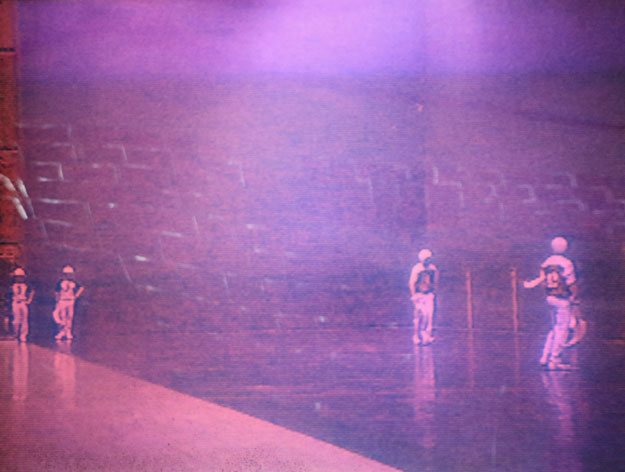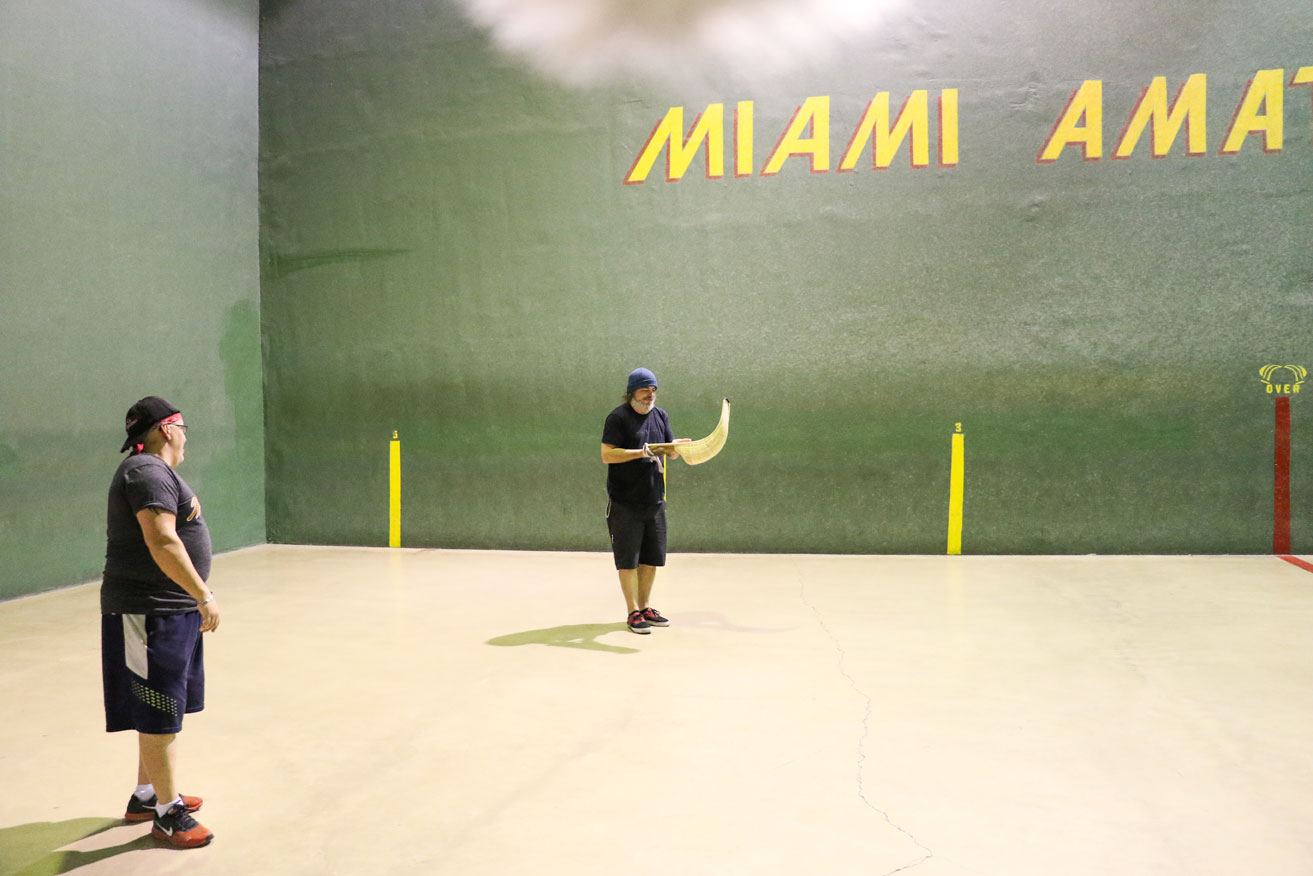Die, Jai, Alai, My Darling
[Originally published in Penthouse magazine as the 10th installment in my monthly column, “Endgame.”]
I meet my wife in Miami every December after she finishes working the Art Basel fair. There are some things we do every visit: drink at the Deuce, eat at Tap Tap, get a frita at El Mago, and watch Jai Alai at the Casino Miami. The latter is a very peculiar experience. For one, the environment at the Casino Miami is one of supreme degradation. If you have an Indian gaming casino in your area, you’ve surely seen TV commercials that portray handsome men and beautiful women having a lovely time eating, drinking, dancing, and gambling responsibly. They could never shoot a commercial like that at Casino Miami. It is a hospice for the walking dead. Nothing but zombies yanking on slots.
The Jai Alai stadium adjacent to the casino isn’t much different. While the game being played on the cancha (court) probably looks no different today than it did back in the golden days of the 80s when cocaine ruled Miami, and sexy waitresses delivered champagne to Tony Montana, today the stadium is nearly empty save for small groups of old, mostly Cuban, men muttering to their betting tickets. (One bets on Jai Alai much like a horse race: win, place, show, exacta, trifecta, etc..) I enjoy it because it’s an interesting place to sit down, have a couple beers, and experience a different side of Miami culture while watching a weird sport that hardly anyone plays anymore.
The game itself is mesmerizing. The players catch the pelota (ball) with their cesta (the weird anteater basket they wear on their hand) and huck it at the end wall. The pelota is “the hardest ball in any sport,” a little smaller than a baseball, and sounds like a billiard ball when it hits the granite wall at nearly 200 mph. There’s something deeply satisfying about the sound of the impact. It’s violent, like a beer bottle breaking on cement, but very precise, like the crack of a bullet. So on my last visit to Miami, I made a point of not just attending the Jai Alai games at the Casino Miami, but I arranged with a local amateur Jai Alai club to actually play the game before it disappears from the face of the earth.
I met with Luis, the owner of the club, in his windowless office next to the cavernous Jai Alai court that fills the warehouse space he shares with a gymnastics training facility. Luis sat at a plastic table with a handful of men playing dominoes. Another half dozen men, the youngest of whom was in his 50s, were playing Jai Alai on the court.
“The sport is dead,” was one of the first things Luis said when I turned on my recorder.
“It’s strange,” I said, “that ‘the fastest sport in the world’ isn’t attractive to young people? I mean, it’s fast, dangerous, and weird.”
Luis blamed the sport’s decline on phones and video games. He pantomimed his kids by making a cross-eyed stupid face while twiddling his thumbs over an invisible phone. He lamented that the casino is cutting back on the number of Jai Alai matches and he predicts it won’t be long before they cancel it altogether. Luis was a nice guy, but talking about the state of his beloved sport made him grumpy.
I was reminded of my conversation with Luis the other day when I saw drone racing on ESPN. What the fuck is drone racing? I have to admit I was amused by the discovery of this new “sport” on multiple levels. First, I laughed because I thought, “I’m old,” as in, “How is this a fucking sport?” My second thought was, “Note to self: write script about a crew of future drone racers, the US military sees their skills on the plasma screen, recruits them to take out a terrorist death star.” And then I thought, “Oh. That could probably really happen… if it isn’t happening already?”
This all got me thinking about the landscape of sport in general. We take our oversaturated sports culture for granted, but the reality is that organized team sport, as we know it, is a relatively recent development in history. Soccer and hockey can be traced back thousands of years to related activities, but baseball, basketball, and football are only a couple hundred years old at best. Sports are born, sports die, and Jai Alai appears to be nearing the end of its life. It made me wonder what a world without team sports would be like? Probably won’t happen in our lifetime, but it’s definitely a possibility.
I heard a Radiolab podcast recently on the subject of football. Chuck Klosterman mentions this same podcast in his book But What If We’re Wrong? (reviewed elsewhere in this issue). The takeaway from the podcast is that data from around the US shows youth participation in all team sports is down. The producers surveyed a swathe of football coaches from around the US who, like Luis, all blame the same culprit: video games.
“The bottom line,” one football coach said about video games, “is that—today—if the kid doesn’t like the score, he just hits restart. He starts the game over.”
Klosterman says this might sound like the reactionary complaint of a disgruntled Luddite. “But sometimes,” he writes, “the reactionaries are right. It’s wholly possible that the nature of electronic gaming has instilled an expectation of success in young people that makes physical sports less desirable. There’s also the possibility that video games are more inclusive, that they give the child more control, and that they’re simply easier for kids who lack natural physical gifts. All of which point to an incontestable conclusion: compared to traditional athletics, video game culture is much closer to the (allegedly) enlightened world we (supposedly) want to inhabit.”
Video game culture is now represented in the XGames and participants (do we call them athletes?) have been awarded medals. Whether or not you agree it’s a “sport” or not, eGaming is definitely a thing and it is well on its way to being a very popular and lucrative thing. A producer friend of mine, Morgan Stone, has done some work in the eGaming community and he said it reminds him of how skateboarding was in the early days before it became more accepted by mainstream culture. “They don’t really understand what they have,” Morgan said about eGamers. “They have a lot of passion, but not sure where they’re going with it.”
One difference between early eGaming and early skateboarding, however, is that there is already a lot of money involved in the former. Morgan, for instance, naively thought that offering a young, but prominent eGamer an all-expense-paid trip to compete in a tournament in Germany, plus a couple grand on top of that, was a very generous offer. But the kid declined to go, saying, “Uh, I can make that much in one day playing at home.”
After Luis and I talked, he led me out onto the court, tied a cesta around my wrist, and I played Jai Alai. Although I use the word “played” loosely. I had no shortage of coaches as Luis and all his friends all had an opinion on how I should throw the ball. I felt what it was like to be the only girl in a bar: I had every boy’s attention. I also threw like a girl. It looks like the easiest thing in the world, but I could not figure out how to huck that thing at the wall. (For reference purposes, I played baseball and hockey as a kid, so I’m familiar with throwing, shooting, and hucking things.) Occasionally the ball left the cesta as intended, but not often enough. Jai Alai is fun, I had a great time, but after an hour of looking like an idiot, I could understand why it wasn’t more popular with kids.
“Luis, that was really hard, but it was fun. Thanks,” I said as I freed my hand from the cesta. “My arm’s going to be really sore, huh?”
“Like you’ve been jacking off for a week,” Luis replied.
So, in conclusion, Jai Alai is done, football is dying, and all the other major sports will be taken out by kids flying military drones—except hockey, which is just going to melt away due to global warming. The end (game).
To play Jai Alai, contact Luis at www.americanjaialai.com.
To watch professional Jai Alai, visit www.casinomiamijaialai.com.




